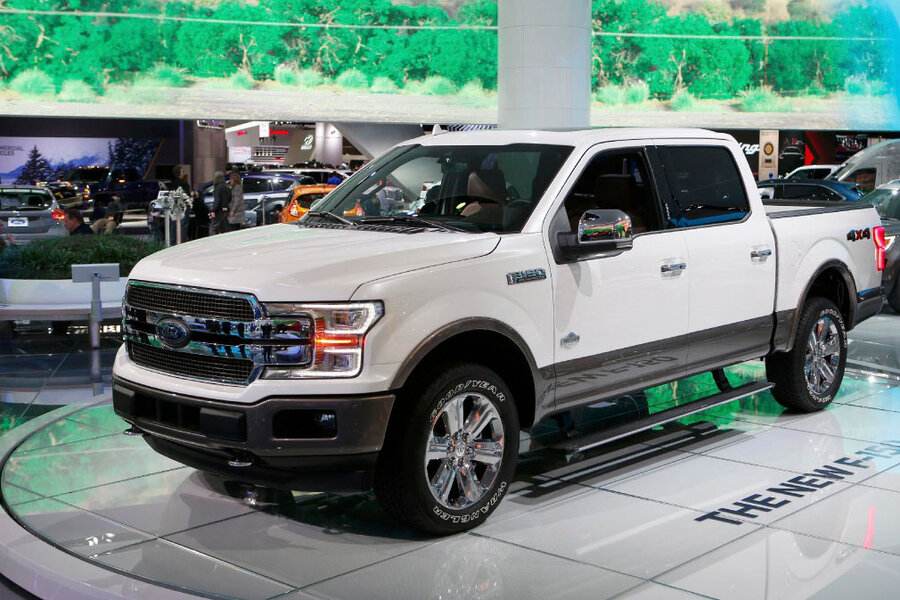Will pickup owners ever trade in their trucks for more efficient cars?
Loading...
The Environmental Protection Agency has hit the gas on its plan to increase US mileage standards. On Wednesday, the EPA completed its midterm evaluation of the government’s plan to raise fuel economy standards, more than a year before the April 2018 deadline.
The midterm evaluation confirms an agreement that the Obama administration reached with automakers in 2012: to raise the average mileage of US cars to 36 miles per gallon for cars built in model years 2022 through 2025. “I am confident that the standards as they currently exist can be met at a reasonable cost,” EPA administrator Gina McCarthy wrote when she signed off on the evaluation.
Automakers disagree.
“The EPA decision is disappointing,” Wade Newton, senior director of communications for the Alliance of Automobile Manufacturers, tells the Monitor in an emailed statement. “Our fundamental priority remains striking the right balance to continue fuel economy gains and carbon reduction without compromising consumer affordability and vital auto-sector jobs. This crucial balance requires a midterm review that proceeds on the original EPA and NHTSA timetable, culminating not now but by April 2018.”
This split with the EPA sets the Alliance, which represents most automakers with US operations, apart from a growing number of businesses, including 365 companies who called on the government in November to increase its commitment to fighting climate change.
“We want the US economy to be energy-efficient and powered by low-carbon energy,” reads their letter to Congress, President Obama, and President-elect Donald Trump. Leaders from state governments, nonprofits, and companies – from industrial giant DuPont to software maker Adobe – signed the letter. But electric-car firm Tesla was the only automaker to sign on.
The auto firms that dominate the US market have made strides in eco-friendliness, however. Toyota has sold more than 9 million of its Prius hybrids; GM’s all-electric Chevy Bolt EV was recently named the 2017 North American Car of the Year.
These companies clearly see profits in environmentally friendly vehicles. But they still have reason to oppose the government’s mileage standards. When other firms seek to reduce their carbon footprint, they can save energy in ways that have little impact on their consumer's experience. For instance, a software firm like Adobe can retrofit its buildings for efficiency, or install solar panels on its roof. A utility like Pacific Gas and Electric, which also signed November’s letter, can switch to renewables or lower-cost natural gas.
But cars are different. Automakers have figure out how to meet consumers' unchanging demands while meeting the government's ever-higher fuel economy standards. This might be easy if most Americans wanted sedans and hybrids. But in 2016, according to Car and Driver magazine, the three best-selling cars in America were pickup trucks.
Automakers see this trend as a major obstacle.
"Given changes in the market landscape, it will be a daunting challenge to meet the very aggressive requirements of the 2022-2025 federal fuel economy and greenhouse gas rule," Gloria Bergquist, vice president of the Alliance for Automobile Manufacturers, told Reuters last summer, when the evaluation was still being prepared.
Last December, Ms. Bergquist called for congressional action to postpone the evaluation’s release. Now, some industry groups want President-elect Trump, a vocal EPA critic, to change course on emissions standards altogether.
“We urge the incoming Trump Administration to withdraw today’s action, and we look forward to working with the new Administration to ensure that working families can choose the cleaner, safer new cars and trucks they need at prices they can afford,” Peter Welch, president and chief executive officer of the National Automobile Dealers Association, said in a statement Friday.
But such an action would also bring opposition – from both environmental groups and consumers. Americans’ growing preference for sustainable products follows them into the showroom. A 2016 survey by Consumers Union found that 53 percent of Americans expect their fuel economy to increase with their next vehicle purchase. Even more tellingly, 60 percent of Republicans who responded agreed that “The US government should continue to increase fuel efficiency standards and enforce them.”
Consumer pressure may well force automakers to continue to improve fuel efficiency standards through the 2020s. To this end, the EPA contends, “Automakers have a wide range of technology pathways available to meet the MY2022-2025 standards.”
So far, car companies have improved gas mileage with their top-selling pickup trucks by shedding weight. Ford, for instance, replaced all the steel in its F-150 pickup with aluminum.
When it did, GM mocked its main US rival with ads that subjected Ford and Chevy pickups to intense tests. The F-150’s aluminum bed became dented and scratched, while the steel Chevy Silverado emerged from the tests unscathed. But if Chevy needs to cut weight further to meet the standards, Ford could have the last laugh.







